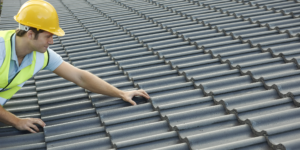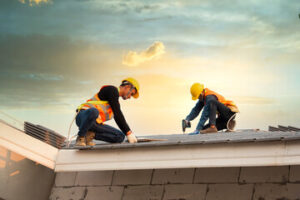A roof is a crucial part of any structure that protects people and things inside from weather. The Structure consists of a frame of rafters or prefabricated trusses built on top of the sheathing.
The sheathing is the wood boards on which your shingles and other roofing materials are installed. Typically, sheathing is plywood or oriented strand board (OSB). Contact Roofing Missoula MT now!

Plywood is a multi-purpose engineered wood-based panel product used in construction. It binds resin and wood fibre sheets to create a composite material sold in panels. Generally, plywood is made up of multiple veneer layers bonded together using an industrial-grade waterproof glue. There are many different types of plywood, and each type is designed for specific uses.
Several types of wood are used to make plywood, including pine, fir, and spruce. It can also be made with mixed species of wood, and specialty types are even designed to meet specific requirements. Regardless of the type of plywood, each sheet is carefully inspected for blemishes and defects before it’s used in construction.
The manufacturing process for plywood starts with cutting large trees into logs. These logs are then transported to the factories where they are soaked and heated in order to soften them up. After that, they are cut into various thicknesses and arranged into long piles known as log decks.
These logs are then used to produce veneers, which are thin sheets of wood that are glued together to create the plywood. The quality of the plywood is determined by how few blemishes and knots are present on the surface. Typically, plywood is graded A, B, C, or D, with A being the highest quality and D being the lowest quality.
It’s important to know the difference between plywood and OSB, which is similar but manufactured differently. While both are used in the foundation of structures, OSB is created from wood strands that are interleaved and bonded together using heat and pressure. This produces a much stronger product than conventional plywood, and it can be used in the same way as standard lumber in some cases.
Regular plywood is not suitable for use in areas that will be exposed to water because it can swell and change shape over time. However, there are specialist types of plywood that can be coated with sealants to make them waterproof, and it’s a good it’s choose this type if you are going to be working on a project that requires a lot of plywood.
Shingles
Shingles are the visible part of a roof, and they play a critical role in the appearance of your home. They are also a crucial component of your roof’s ability to protect your home from the elements and moisture. Understanding the construction of a shingle can help you make a more informed choice when selecting the right roofing materials for your home.
A shingle is composed of a base, granules, and asphalt. The base is a waterproofing agent that holds the granules in place. The granules, which come in a wide variety of colors, give the shingles their visual appeal. They also protect the asphalt from the sun’s ultraviolet rays. The asphalt layer serves as a cushion and helps the shingle resist impact forces from hail or other debris.
There are several different types of shingles, depending on your desired look and function. Strip shingles are the most basic type of shingle, consisting of a single layer with cut-outs that form three individual tabs. They are the least expensive option and are used in most new construction. Dimensional shingles, which are also known as architectural or laminated shingles, use two or more layers of shingle material bonded together to create a multi-dimensional appearance and mimic the look of shake, slate tile, or wood shakes. These shingles are more durable and offer better resistance to weather elements than 3-tab shingles.
Premium or designer shingles are typically higher in price than standard shingle products, but they offer a high-end aesthetic and enhanced performance characteristics such as impact resistance. These shingles can be made from a number of different materials, including natural materials like slate or shake and synthetic materials such as fiberglass or polymers.
The shingles of your roof are one of its most visible features, and a good-looking roof is essential to your property’s curproperty’sKeeping your shingles in good condition requires regular maintenance, including regular cleaning and inspection for damage or persistent problems such as moss.
Most shingles are made from wood, but a few are produced from other materials such as clay or concrete. Many shingle manufacturers offer recycled content as an option for environmentally conscious homeowners. These shingles are a bit more expensive, but they can save you money on energy costs in the long run.
Underlayment
Underlayment is an important component of a quality roofing system. It acts as a barrier against moisture and helps protect the roof deck and interior of your home from damage. The underlayment also contributes to energy efficiency and indoor comfort by regulating the temperature of your home. In the summer, it reflects solar heat to reduce strain on air conditioning systems, while in the winter it prevents warm air from escaping and keeps your house warmer.
During installation, underlayment is placed on the roof deck before installing the actual roofing materials. Depending on your project requirements, you may choose from asphalt-saturated felt, rubberized asphalt or synthetic underlayment. Felt paper is traditional and inexpensive, while rubberized asphalt is a high-quality option that offers superior water resistance. Synthetic underlayment is a more recent invention that’s made frthat’stiple layers of polymers woven together. This newer material is much stronger than felt and resists tearing or moving during the installation process.
If you live in a snowy climate, it’s essential to use an underlayment that is ice-resistant. This will help prevent ice dams from forming when melted snow refreezes around the edges of your roof. An ice-resistant underlayment will also protect the plywood and OSB from moisture. This will prevent rotting and the development of mold, mildew and other harmful substances.
The underlayment is also waterproof, which will protect the roof deck and interior of your home. It will keep rain, snow, and sleet from penetrating the roof deck and damaging your home. If a major weather event causes shingles to become loose, the underlayment will help prevent water from entering your home until the shingles are repaired or replaced.
Whether you’re replaciyou’reingle shingle or a full roof, it’s important to invest in a high-quality underlayment that will provide years of protection for your home. For more information about the importance of underlayment or to request a quote, contact Eagle Roofing today. We proudly serve residential and commercial customers throughout the Seattle area. Our team of experienced and professional installers can provide a high-quality roofing system that will stand up to the elements for decades to come.
Flashing
Flashing is a piece of water-resistant material that is placed in areas where leaks are prone to occur. Most often, this is at the joints between various items and the roof (skylights, chimneys, vent pipes, etc). Flashing is usually made of metals that are resistant to corrosion. It helps to direct water away from the leak prone areas towards gutters and off the roof. Without it or when it deteriorates, leaks can cause serious damage to the structure and interior of the house below.
There are several different types of flashing, all designed to serve a specific purpose. For example, counter flashing is a long strip of metal that is installed where the walls of a building intersect with the roof, like on the sides of a dormer or in a roof valley. It is often covered with shingles. Another type of flashing is step flashing, which is a series of overlapping pieces that are used to waterproof a joint at the top of a chimney. Other types of flashing include pipe flashing, which is a one-piece collar that fits around a pipe’s diametepipe’scan be made of rubber or silicone for easier installation.
Multi-size flashings are another popular type of flashing because they can be used to cover a range of penetration diameters. This means that a single flashing can be used to waterproof multiple items on the roof, saving time and money.
In addition to protecting against leaks, flashing also protects the structure of a home by creating an impermeable barrier between the underlying materials and the elements. This can prevent water or moisture from seeping into the roof structure and causing damage to the insulation and interior of the house.
Leaks are a serious problem in many homes, but they can be prevented with proper roofing and the use of flashing to seal any gaps or seams. By hiring a professional roofing company, such as CoMo Premium Exteriors, homeowners can ensure that their roof is well protected from water damage.

